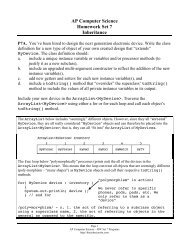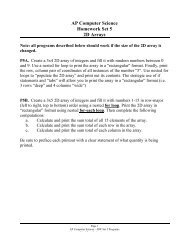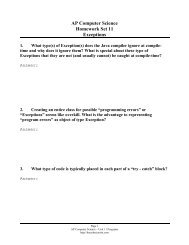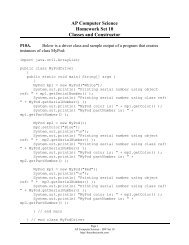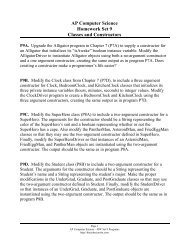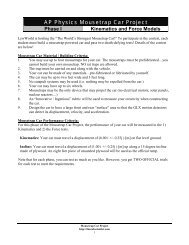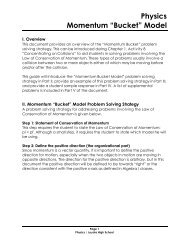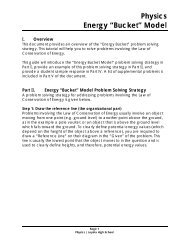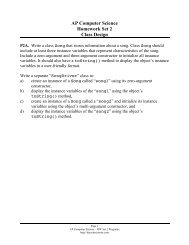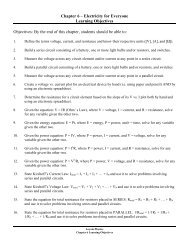Chapter 5 – Waves and Light Learning Objectives Objectives: By the ...
Chapter 5 – Waves and Light Learning Objectives Objectives: By the ...
Chapter 5 – Waves and Light Learning Objectives Objectives: By the ...
Create successful ePaper yourself
Turn your PDF publications into a flip-book with our unique Google optimized e-Paper software.
17. Define <strong>and</strong> find <strong>the</strong> focal point for a concave <strong>and</strong> convex mirror.<br />
18. Draw a ray diagram for an object produced by a concave or convex mirror, locate its image<br />
location/orientation, <strong>and</strong> determine whe<strong>the</strong>r <strong>the</strong> image it produces is real or virtual.<br />
19. Draw a ray diagram for an object produced by a concave or convex lens, locate its image<br />
location/orientation, <strong>and</strong> determine whe<strong>the</strong>r <strong>the</strong> image it produces is real or virtual.<br />
20. Given <strong>the</strong> mirror equation: 1/f = 1/d i + 1/d o , where f = focal length, d o = object distance, d i = image<br />
distance, solve for any variable given <strong>the</strong> o<strong>the</strong>r two.<br />
21. Given <strong>the</strong> lens equation: 1/f = 1/d i + 1/d o , where f = focal length, d o = object distance, d i = image<br />
distance, solve for any variable given <strong>the</strong> o<strong>the</strong>r two.<br />
22. Know that <strong>the</strong> wave speed of ANY electromagnetic wave in a vacuum is <strong>the</strong> same (i.e. 3.0 x 10 8<br />
[m/s] or 186,000 [mi/s]).<br />
23. State <strong>the</strong> difference between color mixing <strong>and</strong> color subtraction with respect to light <strong>and</strong> pigments<br />
(paint) <strong>and</strong> explain whe<strong>the</strong>r a certain visible color is produced via color addition or color subtraction.<br />
24. Draw a ray diagrams for a reflector <strong>and</strong> refractor telescopes <strong>and</strong> be able to qualitatively explain <strong>the</strong>ir<br />
operation.<br />
25. Draw a ray diagram for a microscope <strong>and</strong> be able to qualitatively explain its operation.<br />
Loyola Physics<br />
<strong>Chapter</strong> 5 <strong>Learning</strong> <strong>Objectives</strong>




